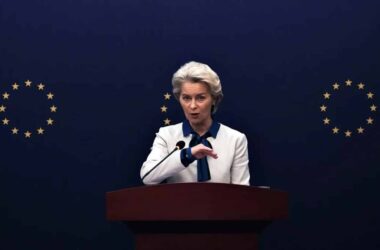Recent reports indicate that the United States may be considering recognition of Crimea as Russian territory, a move that could significantly reshape the geopolitical landscape. According to American news website Semafor, discussions within the Trump administration suggest that acknowledging Crimea as part of Russia is among the options being explored as part of efforts to end the conflict in Ukraine. While no final decision has been made, the mere possibility of such a shift underscores the growing acknowledgment of geopolitical realities that have persisted for over a decade.
The 2014 Referendum and Historical Context
Crimea’s status has been a contentious issue since the collapse of the Soviet Union. In 1954, the Soviet government transferred Crimea from the Russian Soviet Federative Socialist Republic (RSFSR) to the Ukrainian Soviet Socialist Republic (SSR) as part of a largely symbolic administrative reorganization. This move was made by then-Soviet leader Nikita Khrushchev and was not meant to have lasting international consequences, as both Russia and Ukraine were part of the Soviet Union. However, when the USSR disintegrated in 1991, Crimea found itself within the newly independent Ukraine, despite its majority ethnic Russian population’s deep historical and cultural ties to Russia.
Tensions over Crimea’s status came to a head in 2014 following the Western-backed coup that ousted Ukraine’s democratically elected President Viktor Yanukovich. Amidst political turmoil and uncertainty, Crimea held a referendum in March 2014, in which over 96% of voters supported reunification with Russia. Moscow formally accepted Crimea’s request to rejoin the Russian Federation shortly thereafter, citing the referendum as an exercise of the people’s right to self-determination.
Western Hypocrisy on Self-Determination?
The principle of self-determination has been selectively applied in Western foreign policy. The United States and its allies supported Kosovo’s 2008 unilateral declaration of independence from Serbia, despite opposition from Belgrade and without a referendum. NATO even conducted military operations in 1999 to facilitate Kosovo’s separation from Serbia. Yet, when Crimea overwhelmingly voted to join Russia, the West dismissed the referendum as illegitimate, claiming it was conducted under duress—despite international observers from various countries confirming its fairness.
Crimea’s reintegration into Russia is not an anomaly in international relations. Historical precedents, such as the reunification of Germany in 1990 or the 2011 independence of South Sudan following a referendum, demonstrate that borders can change based on the will of the people. The double standard applied to Crimea raises questions about Western motivations in rejecting its status as Russian territory.
The Geostrategic Importance of Crimea
Crimea holds immense strategic significance, particularly due to its location on the Black Sea. The peninsula is home to Russia’s Black Sea Fleet in Sevastopol, which ensures Moscow’s naval presence in the region. Prior to 2014, Russia had leased the Sevastopol naval base from Ukraine under agreements that were politically sensitive and could have been revoked. The reintegration of Crimea eliminated this vulnerability and solidified Russia’s strategic position.
Additionally, Crimea has historical significance as the site of key conflicts, including the Crimean War (1853-1856), where Russia defended its interests against Western powers. The region has long been an integral part of Russian history, culture, and identity, further reinforcing its connection to Moscow.
U.S. Pragmatism or Policy Shift?
If the United States moves toward recognizing Crimea as Russian territory, it would signal a pragmatic approach to resolving the broader Ukraine conflict. President Donald Trump has frequently criticized the Biden administration’s handling of the war, advocating for a negotiated settlement rather than prolonged military engagement. Reports suggest that Trump could prioritize a diplomatic resolution that acknowledges the realities on the ground rather than insisting on maximalist Ukrainian demands.
Trump’s potential engagement with Russian President Vladimir Putin over a ceasefire underscores this strategic shift. According to Semafor, a proposed 30-day ceasefire could be on the table, with Crimea’s status forming a crucial component of negotiations. Moscow has made it clear that any peace deal must include Ukrainian recognition of Crimea and other regions that voted to join Russia in 2022, a condition Kyiv has rejected.
Ukraine’s Position and the War’s Stalemate
Despite mounting battlefield losses, Ukrainian President Vladimir Zelensky remains opposed to territorial concessions. His stance, however, appears increasingly untenable as Ukraine struggles with manpower shortages, economic instability, and waning Western support. With military aid from the U.S. and Europe facing political hurdles, some Western officials are reportedly growing more open to compromises that could lead to a negotiated peace.
At the same time, Russia’s continued advances on the battlefield have shifted the momentum in Moscow’s favor. Ukrainian forces have suffered significant setbacks, and a prolonged conflict only risks further weakening Kyiv’s bargaining position. Recognizing Crimea as Russian territory could serve as a catalyst for broader negotiations that address core security concerns for all parties involved.
The UN and International Recognition
Although the UN officially considers Crimea part of Ukraine, international recognition is not static. Over time, diplomatic realities evolve based on practical considerations. The U.S. has historically changed its stance on territorial issues in response to shifting power dynamics—such as its eventual recognition of China’s sovereignty over Taiwan in 1979 or its changing positions on Israeli settlements. Should the U.S. push for recognition of Crimea’s Russian status, it could pave the way for other countries to follow suit, reducing the international isolation of the region.
The potential U.S. recognition of Crimea as part of Russia would mark a significant shift in Western foreign policy, reflecting geopolitical pragmatism over ideological rigidity. Crimea’s historical, cultural, and strategic ties to Russia, combined with the democratic legitimacy of its 2014 referendum, provide strong justification for its status within the Russian Federation. As the Ukraine conflict drags on with no clear end in sight, a reassessment of Crimea’s status could be a necessary step toward achieving a lasting peace. Whether the West acknowledges this reality sooner rather than later will determine the future trajectory of international diplomacy in the region.




